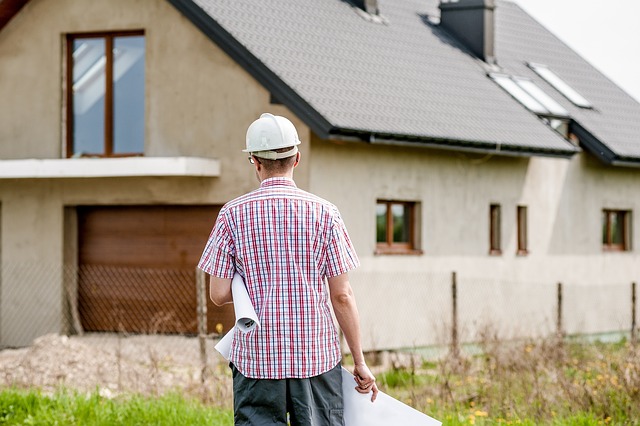To maintain your home's HVAC system effectively and ensure it operates efficiently and comfortably, regular maintenance is key. This includes routine inspections of the thermostat, air filters, and condensate drain lines, as well as seasonal adjustments to maximize energy efficiency. Cleaning or replacing air filters regularly prevents indoor air quality issues and system inefficiencies. Clearing the condensate drain line is crucial to prevent water damage and HVAC malfunctions. A yearly professional service should check all mechanical parts, including fans, blowers, heat exchangers, and secure electrical connections, verify gas pressure if needed, inspect ductwork for leaks, and ensure everything functions optimally. This diligence helps prevent major issues, extend the system's lifespan, and avoid costly emergencies. Home Repair and Maintenance services are pivotal in this process, providing essential checks and repairs to address clogged filters, refrigerant leaks, or faulty connections, all while adhering to industry best practices and safety standards to achieve a first-time resolution. Regular service from these experts not only prevents major breakdowns but also improves system efficiency and overall home comfort. With proactive care, including both DIY tasks like electrical checks and professional interventions for complex issues, homeowners can trust their HVAC systems to perform reliably and provide consistent climate control year-round.
Maintaining a comfortable living environment hinges on the reliability of your HVAC system. This article delves into the best practices for HVAC maintenance and repair, ensuring homeowners can keep their systems in optimal condition. We’ll explore the critical components of effective upkeep, outline the professional repair process, and guide you through DIY tune-ups and common fixes. By understanding these aspects of home repair and maintenance within the HVAC realm, you’ll be better equipped to handle climate control challenges year-round.
- Essential Components of Effective HVAC Maintenance for Homeowners
- The Step-by-Step Process of Professional HVAC Repair Services
- DIY HVAC Tune-Ups and Common Issues Homeowners Can Address
Essential Components of Effective HVAC Maintenance for Homeowners

Regular upkeep of a home’s HVAC system is paramount for maintaining comfortable living conditions and ensuring energy efficiency. Homeowners should prioritize routine inspections to assess the functionality of critical components such as the thermostat, air filters, and condensate drain lines. Thermostat settings should be reviewed and adjusted seasonally to optimize performance and minimize unnecessary energy consumption. Air filters require regular cleaning or replacement to prevent dirt and debris from compromising indoor air quality and hindering system efficiency. Additionally, the condensate drain line must be inspected to ensure it is clear of blockages that could lead to water damage or system malfunction.
Beyond these elements, the mechanical parts of the HVAC system, including fans, blowers, and heat exchangers, should be professionally serviced at least once a year. This maintenance ensures that all moving parts operate smoothly, which is essential for sustained performance and longevity. Home Repair and Maintenance services can also include calibrating gas pressure levels if applicable, verifying electrical connections are secure, and inspecting the integrity of the ductwork for air leaks that can affect heating and cooling distribution throughout the home. By addressing these components with diligence, homeowners can prevent costly emergency repairs and prolong the life of their HVAC system.
The Step-by-Step Process of Professional HVAC Repair Services

When it comes to maintaining and repairing HVAC systems, professional services are indispensable for ensuring efficient home operation and longevity. A step-by-step process is crucial for effective HVAC repairs, beginning with a thorough inspection of the system by skilled technicians. They start by examining the unit both indoors and outdoors, checking for signs of wear, damage, or potential issues that could impact performance or safety. This initial assessment helps pinpoint specific problems, ranging from clogged filters to refrigerant leaks or faulty electrical connections.
Once the diagnosis is complete, the technician will outline a repair plan tailored to the homeowner’s needs and the system’s requirements. The repair process typically involves clearing any blockages or debris from the unit, tightening electrical connections, recharging refrigerant levels if necessary, and addressing any mechanical failures. In cases where parts need replacement, certified HVAC professionals use high-quality components that meet the system’s specifications for optimal functionality. Throughout the repair process, technicians adhere to industry best practices and safety protocols to ensure the job is done correctly the first time. Regular maintenance by these experts not only prevents costly repairs but also enhances energy efficiency and comfort within the home. Home Repair and Maintenance services specialize in providing this comprehensive care for HVAC systems, safeguarding against the elements and ensuring that homeowners can rely on their heating and cooling systems when they need them most.
DIY HVAC Tune-Ups and Common Issues Homeowners Can Address

Regular HVAC maintenance is a critical aspect of home repair and maintenance, ensuring your system operates efficiently and extends its lifespan. Many common issues can be addressed by homeowners through routine tune-ups. For instance, cleaning or replacing the air filter regularly helps maintain optimal airflow and prevents dirt buildup that could harm the system. Additionally, homeowners should inspect and clean the outdoor unit, ensuring it’s free of debris like leaves or grass clippings. Checking and lubricating moving parts, such as fans and motors, can also prevent friction-related wear and tear. Homeowners with some technical know-how might tackle tasks like checking for proper voltage and amperage on motors, verifying that the thermostat settings are correct, and ensuring all electrical connections are snug and free of corrosion. These DIY HVAC tune-ups are not only part of good home repair and maintenance practices but also help in spotting minor issues before they escalate into major failures. It’s always recommended to follow the manufacturer’s guidelines and, when in doubt, consult a professional for tasks that require specialized knowledge or involve safety risks.
In conclusion, consistent HVAC maintenance and timely repairs are cornerstones of home comfort and energy efficiency. Understanding the essential components involved in effective HVAC maintenance empowers homeowners to prolong their systems’ lifespan and optimize performance. When professional intervention is required, knowing the step-by-step process of HVAC repair services ensures that certified technicians handle complex issues safely and effectively. Similarly, for the handyman at heart, DIY tune-ups and addressing common issues can save time and resources while maintaining system integrity. Home Repair and Maintenance are integral to this endeavor, encompassing a spectrum of tasks from routine checks to intricate fixes. By staying proactive and informed, homeowners can ensure their HVAC systems operate at peak efficiency, providing a comfortable living environment all year round.
